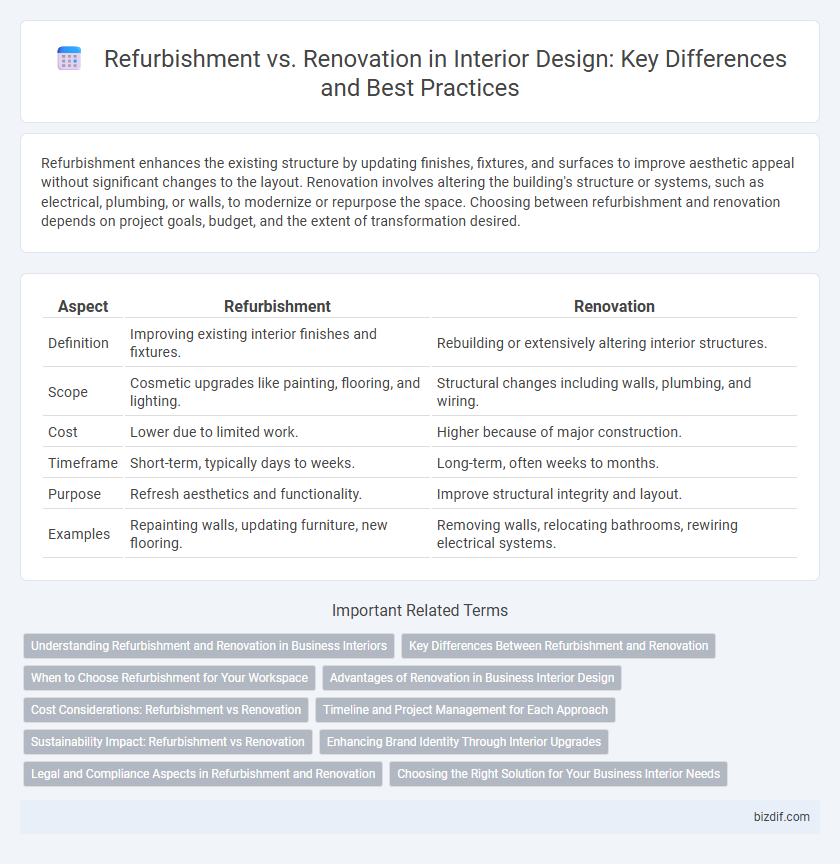Refurbishment enhances the existing structure by updating finishes, fixtures, and surfaces to improve aesthetic appeal without significant changes to the layout. Renovation involves altering the building's structure or systems, such as electrical, plumbing, or walls, to modernize or repurpose the space. Choosing between refurbishment and renovation depends on project goals, budget, and the extent of transformation desired.
Table of Comparison
| Aspect | Refurbishment | Renovation |
|---|---|---|
| Definition | Improving existing interior finishes and fixtures. | Rebuilding or extensively altering interior structures. |
| Scope | Cosmetic upgrades like painting, flooring, and lighting. | Structural changes including walls, plumbing, and wiring. |
| Cost | Lower due to limited work. | Higher because of major construction. |
| Timeframe | Short-term, typically days to weeks. | Long-term, often weeks to months. |
| Purpose | Refresh aesthetics and functionality. | Improve structural integrity and layout. |
| Examples | Repainting walls, updating furniture, new flooring. | Removing walls, relocating bathrooms, rewiring electrical systems. |
Understanding Refurbishment and Renovation in Business Interiors
Refurbishment in business interiors involves updating existing elements to enhance aesthetics and functionality without major structural changes, often including surface repairs, repainting, or replacing fixtures. Renovation entails significant alterations or rebuilds that may affect the building's layout, systems, or compliance standards, aiming to modernize and improve the space extensively. Understanding these distinctions helps companies allocate budgets effectively and plan projects aligned with operational needs and downtime considerations.
Key Differences Between Refurbishment and Renovation
Refurbishment primarily involves cosmetic updates such as repainting, replacing fixtures, and improving finishes to enhance aesthetics without altering the building's structure. Renovation encompasses more extensive changes including structural modifications, system upgrades, and reconfiguring spaces to improve functionality and comply with current standards. Understanding these distinctions is crucial for budgeting, project scope, and achieving desired outcomes in interior design projects.
When to Choose Refurbishment for Your Workspace
Refurbishment is ideal for workspaces requiring cosmetic upgrades such as fresh paint, new flooring, or updated fixtures that enhance aesthetics without altering the structural layout. Choosing refurbishment minimizes downtime and reduces costs compared to full renovation, making it suitable for businesses needing quick, budget-friendly improvements. Prioritize refurbishment when the goal is to refresh the environment while maintaining existing functional elements and spatial configurations.
Advantages of Renovation in Business Interior Design
Renovation in business interior design enhances brand identity by updating spaces to reflect current market trends and corporate culture, increasing customer engagement and loyalty. It optimizes functionality and efficiency, improving workflow and employee productivity through modernized layouts and technology integration. Renovation also tends to be more cost-effective than complete refurbishment, minimizing downtime and allowing businesses to maintain operations during the upgrade process.
Cost Considerations: Refurbishment vs Renovation
Refurbishment typically incurs lower costs as it involves cosmetic updates like painting, flooring, or fixture replacements without altering the structure, making it ideal for budget-conscious interior design projects. Renovation often requires substantial investment due to structural changes, plumbing, or electrical rewiring, significantly increasing material and labor expenses. Understanding the scope and objectives helps prioritize budget allocation, ensuring cost-effective decision-making between refurbishment and renovation.
Timeline and Project Management for Each Approach
Refurbishment projects typically have shorter timelines, ranging from a few days to several weeks, due to their focus on cosmetic updates and minimal structural changes, allowing for quicker turnaround and less complex project management. Renovation involves extensive modifications or structural work, often extending the timeline to several months and requiring detailed planning, coordination with contractors, permits, and phased scheduling to manage disruptions effectively. Efficient project management for refurbishment relies on streamlined procurement and quick decision-making, whereas renovation demands comprehensive resource allocation, risk management, and milestone tracking to ensure timely completion.
Sustainability Impact: Refurbishment vs Renovation
Refurbishment significantly reduces environmental impact by preserving existing structures and materials, minimizing waste and lowering carbon emissions compared to full-scale renovations. Renovation often involves extensive demolition and replacement, leading to higher resource consumption and increased landfill contributions. Opting for refurbishment supports sustainable interior design by extending the lifecycle of buildings and promoting resource efficiency.
Enhancing Brand Identity Through Interior Upgrades
Refurbishment focuses on restoring and updating existing interior elements to reflect the brand's personality, reinforcing brand identity through subtle yet impactful changes. Renovation involves more extensive structural modifications that allow for a complete reimagining of space, enabling businesses to align physical environments with evolving brand values. Strategic interior upgrades, whether refurbishment or renovation, boost customer experience and solidify brand recognition by creating cohesive, memorable atmospheres.
Legal and Compliance Aspects in Refurbishment and Renovation
Refurbishment projects often require adherence to specific building codes and regulations focused on preserving existing structures, with permits typically centered around maintenance and minor alterations. Renovation involves more extensive modifications that may necessitate comprehensive compliance with updated zoning laws, safety standards, and environmental regulations, often triggering the need for detailed inspections and official approvals. Understanding local legal frameworks and obtaining the necessary permits for both refurbishment and renovation ensures project legitimacy and prevents potential fines or work stoppages.
Choosing the Right Solution for Your Business Interior Needs
Refurbishment improves the aesthetics and functionality of your business interior by updating finishes, fixtures, and furniture without altering the structure, offering a cost-effective, quicker solution. Renovation involves more extensive work such as structural changes, rewiring, or plumbing updates, making it ideal for businesses requiring significant layout modifications or compliance upgrades. Assess your business goals, budget, and timeline to determine whether a refurbishment or renovation best aligns with your interior design needs and operational requirements.
Refurbishment vs Renovation Infographic

 bizdif.com
bizdif.com